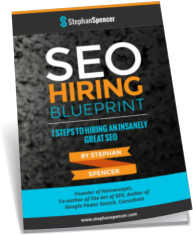In the SEO world, Google is king. That means if you run a website, it’s critical to play by Google’s rules. Otherwise, you may end up on the wrong side of a dreaded Google penalty and see a big drop in your rankings, traffic, and overall revenue.
I’ve spent years learning how to steer clear of fatal mistakes and Black Hat techniques that leave sites vulnerable to penalties.
Though Google’s algorithm is constantly evolving, avoiding a penalty is mostly common sense. Here are some of my quick hitting tips to ensure you stay on Google’s good side.
1. Avoid Paid Links
Let’s face it: link building can be a pain. It’s tedious, unpredictable, and above all, time consuming. So there’s no denying the allure of paid links. The promise of a quick rankings gain or traffic boost may seem too good to pass up.
But hold off before pulling out your credit card. In addition to being expensive, paying for links is just bad business. Google has a firm anti-paid link stance.
Choosing to invest in paid link building will put you on the fast-track to a penalty. There’s no substitute for the real thing when it comes to link building.
If you’re looking for “virtuous” link building tips, check out my in-depth discussion with link building expert Julie Joyce on the Marketing Speak podcast.
2. Create Original Content
Creating original content is no walk in the park. It takes research, commitment, and skill.
Unfortunately, too many people to forego the writing process and try to game the system instead. They might keyword stuff their articles or recycle information in an attempt to get a traffic boost.
Not only is this bad for your Google rankings, it’s bad for your readers. People want to read informative, helpful articles—not content written for an algorithm! Looking for help with your content? Try using tools like Hemingway, Grammarly, and Searchmetrics Content Composer to create optimized content.
3. Regularly Audit Your Site
Think your site is squeaky clean? Think again. Even the most white-hat SEOs can fall prey to “negative SEO”.
Negative SEO occurs when people try to viciously attack their competitors to enhance their own rankings.
The best way to protect yourself is to regularly audit your site. Monitor analytics reports, your backlink profile, and check for unusual activity. You should also check that nobody has duplicated or plagiarized your content with the help of tools like Copyscape.
4. Get Rid of Low Quality Links
If you have poor quality links pointing to your site, you should get rid of them as soon as possible.
To see your backlink profile, try using tools like LinkResearchTools, Majestic, Ahrefs, Moz’s Open Site Explorer, and Google Search Console. Next, compile a list of risky backlinks that you can remove. The remaining links can be disavowed by using the Disavow Tool in Google Search Console, which will signal to Google that you want to exclude them from being crawled.
The Link Detox tool from LinkResearchTools can help you streamline this process if you have huge numbers of backlinks. You can also check out my article on Search Engine Land for a more in-depth tutorial.
5. Sign Up For Google Search Console
If you’re investing in SEO and you’re not using Google Search Console, you’re missing the boat.
Google Search Console is a handy tool for many reasons, but perhaps most importantly it will alert you when it identifies issues on your site. You’ll also get an email notifying you if Google has taken manual action on your site. You can respond and notify Google when you’ve fixed issues so you can get your back on track.
Use these strategies to stay on Google’s good side and to optimize your site without the fear of a dreaded penalty. For more SEO tips, tricks, and tools, tune into my Marketing Speak podcast.
Photo by Dmitry Abramov from Pixabay

 SIGN UP FOR EXCLUSIVE WEEKLY CONTENT
SIGN UP FOR EXCLUSIVE WEEKLY CONTENT 


Leave a Reply